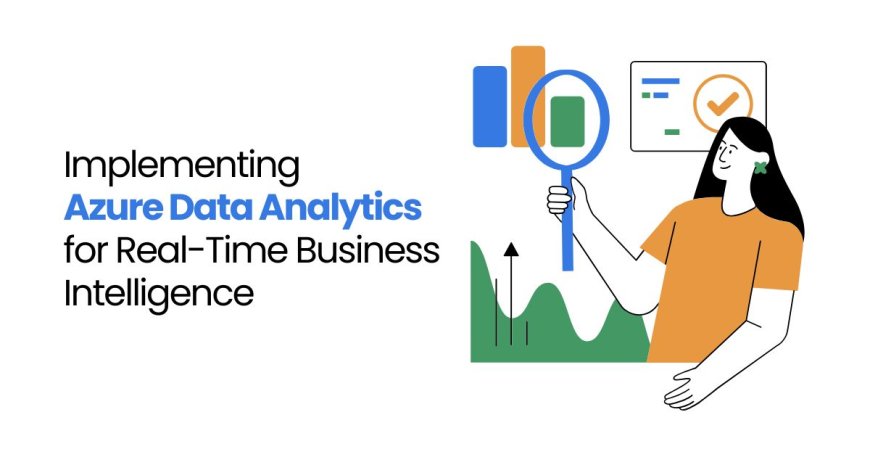Implementing Azure Data Analytics for Real-Time Business Intelligence
Discover how Azure Data Analytics powers real-time business intelligence, delivering actionable insights for smarter decisions.

In today's fast-paced business environment, the ability to make real-time, data-driven decisions is crucial for staying competitive. According to a report by Microsoft, 85% of businesses consider data analytics essential for their growth and decision-making processes. Azure Data Analytics services provide organizations with the tools they need to harness the full potential of data, enabling real-time insights that drive better business outcomes.
This article explores how businesses can implement Azure Data Analytics to enable real-time business intelligence (BI). We'll also discuss key components, tools, and strategies that organizations can use to build a robust and efficient data analytics infrastructure on Azure.
Why Real-Time Business Intelligence Matters
Real-time business intelligence (BI) involves the continuous monitoring and analysis of data as it is generated, enabling businesses to make informed decisions instantly. Traditional BI systems often rely on historical data, which can lead to delayed decisions and missed opportunities. In contrast, real-time analytics empowers businesses to act on current data, making them more agile and responsive to market conditions.
Benefits of Real-Time Business Intelligence:
-
Faster Decision Making: Organizations can react to market changes immediately, optimizing business performance.
-
Improved Customer Experience: Real-time data enables businesses to personalize services and respond to customer needs quickly.
-
Competitive Advantage: With instant insights, companies can stay ahead of competitors who are using slower, traditional BI methods.
-
Cost Efficiency: Real-time analytics helps identify issues early, preventing costly delays and errors.
Key Components of Azure Data Analytics Services
Azure offers a comprehensive suite of data analytics tools that can be integrated to build an effective real-time BI system. These services work together seamlessly, providing businesses with powerful insights in real-time.
1. Azure Synapse Analytics
Azure Synapse Analytics, formerly known as Azure SQL Data Warehouse, is a unified analytics platform that allows organizations to ingest, prepare, manage, and serve data for BI. It enables real-time analytics by processing both structured and unstructured data at scale.
-
Real-Time Data Ingestion: Azure Synapse allows businesses to ingest real-time data from various sources, such as IoT devices, social media, and customer interactions.
-
Advanced Analytics: Synapse integrates with Azure Machine Learning and Spark, allowing businesses to run advanced predictive analytics and machine learning models on real-time data.
2. Azure Stream Analytics
Azure Stream Analytics is a real-time data stream processing service that enables businesses to analyze and process data from various sources as it is generated. It provides real-time insights by processing data in motion, making it perfect for industries like e-commerce, banking, and manufacturing.
-
Real-Time Data Processing: Stream Analytics supports various data sources like social media feeds, sensors, and transaction logs, ensuring businesses get actionable insights in real time.
-
Integration with Power BI: The service integrates seamlessly with Power BI, allowing businesses to visualize and share real-time analytics.
3. Azure Data Lake Analytics
Azure Data Lake is a scalable and secure data lake that enables businesses to store vast amounts of structured and unstructured data. It supports big data analytics and integrates with tools like Azure Synapse and Power BI for real-time reporting and insights.
-
Real-Time Storage and Access: Azure Data Lake stores data in its raw form, making it easy for businesses to access and analyze real-time data without the need for complex data transformation.
-
Scalability: Azure Data Lake can scale to handle increasing volumes of real-time data, ensuring that businesses can keep up with growing data demands.
4. Power BI for Real-Time Reporting
Power BI is a business analytics service that provides interactive visualizations and real-time reporting capabilities. It connects with Azure data analytics services like Synapse, Stream Analytics, and Data Lake to display real-time insights.
-
Real-Time Dashboards: Power BI offers interactive dashboards that update in real time, making it easy for business leaders to monitor key metrics and KPIs.
-
Data Sharing: Power BI allows businesses to share real-time reports across teams, ensuring everyone has access to the latest data.
5. Azure Machine Learning
Azure Machine Learning is a cloud-based service for building, training, and deploying machine learning models. By integrating Azure ML with real-time data analytics, businesses can gain predictive insights that enable proactive decision-making.
-
Predictive Analytics: Businesses can use machine learning models to analyze real-time data and predict future trends, customer behaviors, or equipment failures.
-
Automated Workflows: Azure ML can automate the process of applying machine learning models to live data, ensuring businesses can act on predictions immediately.
How to Implement Azure Data Analytics for Real-Time BI
Implementing Azure Data Analytics for real-time business intelligence involves several steps. These steps ensure that organizations set up a robust infrastructure capable of processing and analyzing data in real time.
Step 1: Define Business Requirements
Before implementing any tools, it’s essential to clearly define the business objectives. Determine the key metrics you want to track, the data sources you’ll need, and the insights you require to make informed decisions.
Example: A retail company may want to track customer purchasing behavior in real time to adjust promotions and inventory levels accordingly.
Step 2: Choose the Right Azure Services
Select the appropriate Azure services based on your business needs. For example:
-
If you need to analyze large datasets, choose Azure Synapse Analytics.
-
For real-time stream processing, Azure Stream Analytics is a great choice.
-
To store and analyze unstructured data, Azure Data Lake might be suitable.
Step 3: Set Up Data Pipelines
Data pipelines are essential for collecting, processing, and transforming data in real time. Use Azure Data Factory to create automated data pipelines that pull data from various sources and feed it into analytics tools like Azure Synapse and Stream Analytics.
Example: A healthcare provider could set up a data pipeline to collect patient data in real time from medical devices and sensors, which can then be processed for monitoring health conditions.
Step 4: Implement Real-Time Data Processing
Once the data pipelines are set up, the next step is to implement real-time data processing. Use Azure Stream Analytics to process incoming data from various sources in real time.
Example: In an e-commerce business, real-time data from customer transactions, website clicks, and inventory systems can be analyzed using Azure Stream Analytics to provide insights into customer behavior.
Step 5: Build Real-Time Dashboards with Power BI
With the processed data, use Power BI to build real-time dashboards and reports. These dashboards provide business leaders with up-to-date insights and metrics, helping them make data-driven decisions quickly.
Example: A manufacturing company could use Power BI to monitor real-time production data, track performance metrics, and identify potential bottlenecks.
Step 6: Apply Machine Learning for Predictive Insights
Integrate Azure Machine Learning to apply predictive models to real-time data. This will allow businesses to anticipate trends, customer behaviors, or potential issues before they occur.
Example: A logistics company could use machine learning to predict delivery delays based on real-time traffic and weather data, enabling proactive customer communication.
Challenges and Solutions in Implementing Real-Time BI with Azure
While Azure provides powerful tools for real-time business intelligence, organizations may encounter several challenges during implementation. Understanding these challenges and how to overcome them is essential for a successful implementation.
1. Data Quality Issues
Real-time data is often noisy, incomplete, or inconsistent. Ensuring data quality is essential for accurate insights.
Solution: Use Azure Data Quality Services to clean, validate, and standardize data before it is analyzed. Additionally, set up automated data validation processes within your data pipelines.
2. Scalability Concerns
As the volume of real-time data grows, organizations may face scalability challenges in processing and storing data.
Solution: Azure services like Azure Synapse and Azure Data Lake are designed to scale with your data needs. These services can handle large datasets efficiently, ensuring that your analytics infrastructure can grow with your business.
3. Integration Complexity
Integrating various data sources, analytics tools, and machine learning models can be complex.
Solution: Leverage Azure Data Factory to automate the integration of data from various sources. This will help simplify the process of data ingestion and transformation, making it easier to set up a unified data analytics infrastructure.
Conclusion
Implementing Azure Data Analytics for real-time business intelligence enables organizations to make timely, data-driven decisions that can significantly improve business performance. By leveraging Azure’s comprehensive suite of data analytics services, businesses can streamline their data processing, integrate real-time analytics, and unlock the power of predictive insights.
When choosing an Azure Data Analytics company for your business, it's essential to select one with deep expertise in Azure services and a track record of successful real-time analytics implementations. By partnering with the right experts, you can ensure your real-time BI systems are set up efficiently and effectively, giving your business the competitive edge it needs to thrive in today’s fast-paced market.
What's Your Reaction?























